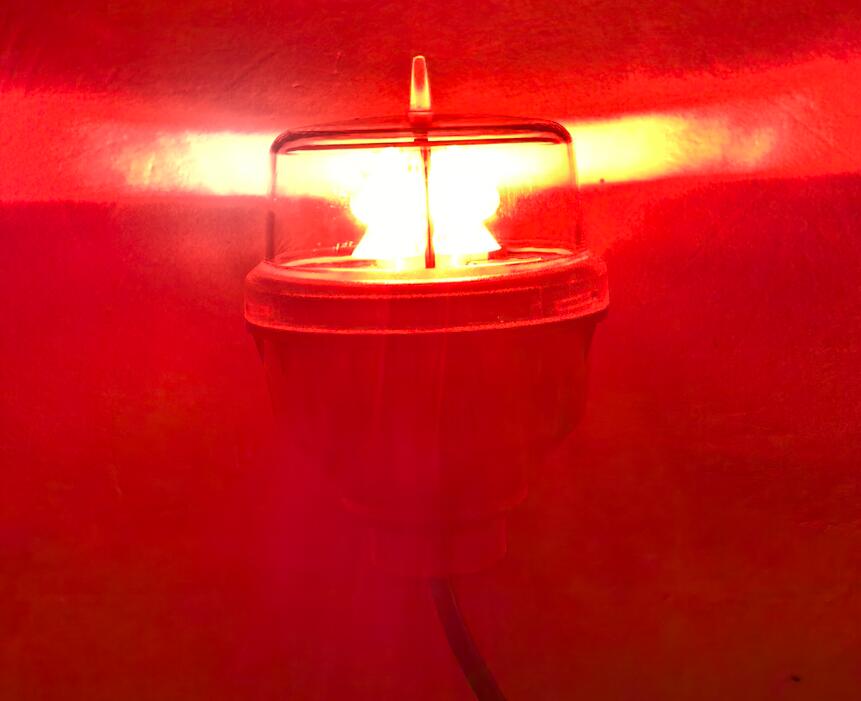
In today’s rapidly developing urban and rural landscapes, tall structures such as telecommunication towers, wind turbines, and high-rise buildings are becoming increasingly common. While these structures support essential infrastructure, they also introduce potential hazards for low-flying aircraft. To ensure the safety of air traffic, the Federal Aviation Administration (FAA) mandates the use of FAA red obstruction lights as a critical component of its obstruction marking and lighting regulations.
What Are FAA Red Obstruction Lights?
FAA red obstruction lights are aviation safety devices specifically designed to mark obstacles that could pose a risk to pilots, especially at night or in low-visibility conditions. These lights emit a red signal that either flashes or burns steadily, depending on the application and the structure's height.
The FAA classifies these lighting systems primarily under three types:
L-810: Steady-burning red lights used for structures under 150 meters.
L-864: Flashing red beacons used for structures above 150 meters.
L-885/886: Dual lighting systems that combine red and white lights for day and night use.
All FAA red obstruction lights must meet the standards outlined in FAA Advisory Circulars such as AC 70/7460-1M and AC 150/5345-43J.
Why Are They Important?
The primary function of FAA red obstruction lights is to prevent collisions between aircraft and tall, stationary structures. During nighttime or inclement weather, when visibility is limited, these lights serve as unmistakable visual cues for pilots. The steady or flashing red light indicates the presence of an object that might otherwise be invisible until it’s too late.

By clearly marking structures, these lights contribute significantly to:
Reducing mid-air collisions
Supporting low-altitude night operations
|
faa red obstruction lights |
Complying with federal aviation safety requirements
Minimizing liability risks for structure owners
Key Applications Across Industries
FAA red obstruction lights are widely implemented across various sectors, including:
1. Telecommunication Towers
As wireless communication expands, the number of cellular and broadcast towers has grown dramatically. These towers are often erected in remote areas or on elevated terrain, making them particularly hazardous to aircraft. FAA red lights ensure these towers are marked effectively.
2. Wind Energy Installations
Modern wind turbines can exceed 500 feet in height, and are often installed in open, low-traffic areas where radar coverage may be limited. Marking them with FAA red obstruction lights ensures pilots can identify turbine locations from a distance.
3. High-Rise Buildings and Cranes
Urban development projects frequently require temporary or permanent lighting systems on cranes and tall buildings. FAA red obstruction lights help pilots operating near city airports or heliports avoid such hazards.
4. Power Transmission Lines
Transmission towers that span across valleys or rivers pose a unique risk due to their elevation. Installing red obstruction lighting on the highest points of these towers ensures they are visible during nighttime flights.
Technology and Compliance
Modern FAA red obstruction lights often use LED technology due to its advantages in energy efficiency, lifespan, and maintenance. LEDs also offer consistent light output and faster response times, making them a reliable choice for critical aviation safety systems.
Additionally, these lights are equipped with:
Photocell sensors to enable automatic activation during dusk and deactivation at dawn.
Fail-safe monitoring systems that notify operators of malfunctions.
Weatherproof and corrosion-resistant housings for outdoor durability.
To remain compliant with FAA rules, structure owners must:
Conduct regular inspections
Replace or repair faulty lights promptly
Ensure lights operate continuously when required
Failure to comply can result in fines, increased liability, and FAA enforcement actions.
Integration with Other Aviation Safety Systems
FAA red obstruction lights are often integrated into broader aviation safety systems that include radar reflectors, GPS-based warning zones, and aircraft navigation systems. In some cases, they are used in combination with medium-intensity white strobe lights or dual lighting systems, particularly when day and night visibility is critical.
The choice between red or white lighting often depends on the structure’s environment. Red lights are ideal for areas where minimizing light pollution is essential, such as near residential zones or protected night sky regions.
The Future of FAA Red Obstruction Lighting
As infrastructure evolves, so too does the need for more advanced and efficient obstruction lighting systems. Innovations in smart monitoring, remote diagnostics, and solar-powered configurations are already being implemented to reduce maintenance costs and environmental impact.
Moreover, as drone operations and urban air mobility increase, the need for comprehensive, real-time obstacle awareness is growing. FAA red obstruction lights will play an increasingly vital role in this new aviation landscape, acting as visible anchors in a more complex and layered airspace system.
FAA red obstruction lights are far more than simple beacons on towers—they are essential safety components that protect lives and prevent accidents. By marking vertical obstacles with clear, standardized visual signals, these lights allow pilots to navigate safely even in the most challenging conditions. As aviation technologies and urban environments continue to develop, the role of red obstruction lighting remains foundational in safeguarding the skies.